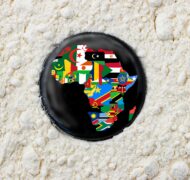Multiculturalism
Book / Produced by partner of TOW
Most newer Western societies, and increasingly some older ones, are made up of people from many ethnic, national, religious, linguistic and geographical regions of the world. These people came, and still come, carrying with them the culture in which they were raised. The meeting of these cultures in new social settings results in the process known as multiculturalism.
Our human identity is shaped dialogically, through our relationships with others. If we learn about and from each other, especially those who are different from us, we will be more tolerant and accepting. Multiculturalism is people from varied ethnic and cultural origins living together in harmony.
The Emergence of Multiculturalism
In the past the term cultural pluralism expressed the dominant “melting pot” image that symbolized the assimilation of immigrants into the USA, an assimilation requiring both linguistic and cultural adjustments. Pluralism is covered in a separate article. Multiculturalism was coined in the early 1960s to define the official government policy of the Canadian “mosaic,” which encouraged immigrants to retain their cultural and ethnic diversity as a mark of identity. Such immigrants had to choose between French and English, but more recently other cultural heritages have been encouraged through government policy. The definition of multiculturalism has changed somewhat over the years and is now used wherever there is an egalitarian recognition of ethnic or racial difference. This is often embodied in such terms as African-American, Asian-American, French-Canadian and Chinese-Canadian.
As an ideology, multiculturalism represents the institutionalization of distinctiveness, answering the need for personal cultural recognition. It assumes mutual tolerance and coexistence between ethnic groups and presupposes a low degree of prejudice and discrimination. Multiculturalism strives for “difference-blindness” and at the same time assumes relativism—every approach to values and culture is equally valid. Critics of multicultural policy suggest that it is not in fact antiracist and fails to address racism by accentuating the peripheral aspects of a culture such as the arts, festivals, food and clothing. Vertical racism, that gives privileges to some and discriminates against others on the basis of arbitrary racial factors, is especially unaddressed by this ideology.
As a process, multiculturalism assumes movement along some continuum from a monocultural understanding (including ethnocentrism) through biculturalism to a more complex social reality. To achieve this people must learn communication skills and form crosscultural relationships. Supporters of multicultural education submit that people need to feel comfortable in settings where cultures other than their own are represented (Pusch, p. 21), in classrooms, community meetings, churches and business settings. This process involves not only an individual but a communal adjustment. Supporters of multiculturalism suggest that changes in educational content will help students discover the value of other ethnic traditions and cultures through exposure at an early age to varieties of ethnic food, dress, festivals, literature, music and art. It is still being debated whether multiculturalism truly counteracts racism.
The Liberal Democratic Roots
Multiculturalism has at its roots the basic premise of a liberal democracy, that people are all free, equal and able to determine their own good. Building on this, multiculturalism adds that ethnic and cultural differences should be respected and sustained. Such democracies are then forced to balance two different political policies: the position of political neutrality on such matters as the total separation of state and church, and the institutionalization of different, perhaps opposing cultures. The basic assumption that all people are free and equal, now being challenged as a Western point of view, is not shared by all nations or religions.
Supporters of multiculturalism suggest that voluntary maintenance of ethnic and cultural ties has several advantages for the immigrant (Alladin). It provides a place to belong when the newcomer is first in the country, provides strong economic possibilities based on ethnic connections and opens up an easier access to political voice. Multiculturalism provides a way of reducing disharmony between diverse ethnic groups as well as providing a place for those groups who do not assimilate. It also challenges the rigid and close-minded to become more open.
By its very definition multicultural society encompasses a range of moral disagreements on a variety of issues, including the value of different cultures. Paradoxically, supporting cultural diversity can result in encouraging opposition to the basic tolerance on which that recognition rests. Cultural institutions can develop that may oppose the liberal democracy that allows their existence. Resolution of such disagreements requires the educational effort of state, schools, churches and community groups.
Opponents of multiculturalism suggest that the process creates ethnic divisions and enclaves that fight against the collective national efforts. Critics ask what it means to be a hyphenated citizen and what happens to loyalties when the nation calls for support. They argue that ethnic groups become exclusivist and promote homogeneity for the purpose of securing political power. Multiculturalism also fails to address the differences within an ethnic group. There can be substantial class differences between immigrants, particularly if government selection of immigrants gives preferential entry to the highly educated or financial elite and, at the other end of the spectrum, refugees. How are we to think of this?
Multiculturalism in Christian Perspective
As early as historic records have been kept, humans have been faced with the relocation of people and the occupation of homelands by stronger tribal or national groups. This is demonstrated by the records of Egyptian and Babylonian expansion, the exploits of Alexander the Great and the growth of the Roman Empire. Some of the struggles associated with this are reflected in the Bible. For example, when the Israelites were exiled to Babylon, the prophet Jeremiah encouraged them to work and live there, adapting to their new situation but still preserving their religious faith as they continued to pray for their deliverance and return to their own land. The Old Testament law, however, instructs the Jews to strictly enforce the Jewish religious regulations even for foreigners living in their land (Exodus 12:19, 48; Exodus 20:10). And the Jews struggled to maintain their Jewish distinctiveness in a foreign land.
Paul’s suggested method for reaching people with the gospel was remarkably different. He tried to understand the customs and practices of those he hoped to influence, becoming like the people he wanted to reach. “I have become all things to all men so that by all possible means I might save some” (1 Cor. 9:22). Paul went to them—the essence of the idea of mission—but today the multicultural climate has brought the ethnic and cultural mix to us. Differing forms of worship, ritual practices, rites of passage and even religious attire are no longer the stories of foreign lands and mission fields; they are part of the multicultural community. To apply Paul’s principle today, we must learn as much as possible about the culture of our neighbors in order to live alongside them and present the gospel. Debate rages today about how to do this without falling into relativism on the one hand or exclusivism on the other. The values, the worldview and the religious belief of my neighbor may include ways to salvation outside of Christ.
Where do we go from here? The school and the church need to promote teaching which helps to reduce tensions between ethnic groups, supporting antiracism and combating discrimination. To develop intercultural competence we need to understand our own worldview and how our ethnocentrism can be reshaped. We need an increased global awareness of how our actions, decisions and lifestyles affect other people. Multiculturalism, instead of rendering mission work obsolete, provides an opportunity for the church to fulfill its missionary task. The stakes are high at the global level. We can strive for harmony, or we can return to isolationism and suspicion and all that comes from them.
» See also: Community
» See also: Ethnocentrism
» See also: Global Village
» See also: Information Superhighway
» See also: Pluralism
» See also: Racism
References and Resources
M. I. Alladin, ed., Multiculturalism in the 1990s: Policies, Practices and Implications (Edmonton: EISA Publishers, 1993); F. Anthias, “Connecting `Race’ and Ethnic Phenomena,” Sociology 26, no. 3 (August 1992); N. Bissoondath, Selling Illusions: The Cult of Multiculturalism in Canada (Toronto: Penguin, 1994); A. Schlesinger, The Disuniting of America (New York: Norton, 1992); C. E. Sleeter, ed., Empowerment Through Multicultural Education (Albany: State University of New York Press, 1991); C. Taylor, Multiculturalism: Examining the Politics of Recognition (Princeton: Princeton University Press, 1994); R. Todd, Education in a Multicultural Society (London: Cassell, 1991).
—Brian F. Stelck





